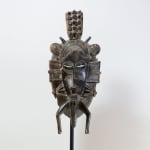Senufo Wooden Kpeliye'e Mask, 20th Century CE
Wood
X.1027 (LSO)
Further images
This imposing mask is a kpeliyee model, worn by members of the Senufo Poro secret society during dances and meetings. It is a very refined example of the genre, made...
This imposing mask is a kpeliyee model, worn by members of the Senufo Poro secret society during dances and meetings. It is a very refined example of the genre, made in dark wood with a gloss patina. The “hood” section is larger than the face itself, which is elongated with uplifted slit eyes, a long nose, a small mouth and a pointed beard. The sides of the face are decorated with numerous small eminences in geometric form. The apex bears a club-like crest decorated with spikes. The bottom of the mask bears a paif or “legs”. The face is decorated with small incisions and representations of keloid scarifications.
The Senufo live across the Ivory Coast, Mali and Burkina Faso, and are one of West Africa’s most artistically important groups. They are governed by a council of elders and the Poro society, and a religious foundation principle stating that ancestors and bush spirits (mandeo) are all around, and must be appeased. This and other beliefs are visible in their artworks.
Masks include kpeliyee (for dances), buffalo (initiations), horse (celebrating Poro elders) and “firespitter” forms, which are worn for crises and funerals. Healers and highly productive farmers are also entitled to wear masks. The most famous sculptures are the “pombibele” rhythm pounders, which represent primordial humanity, and are used to tamp down the earth of prominent Poro members’ graves. Very large kasingele (first ancestor) sculptures were placed in yasungo shrines, and also appeared in the form of birds (sejen) which are carried by initiates, and which symbolise the authority of the Poro elders (katyleeo) over their juniors (poro piibele). Sandogo divination paraphernalia is also known, while secular items are carved in a very specific manner that echo Senufo deities and spirits, thus providing an apotropaic function.
Kpeliyee (there are various spellings) masks are worn for a number of Poro functions, and may be seen by the public at certain festivals. The manners in which they are carved betray their precise origin, through carving method and details such as scarifications. The general characteristics are similar, however, with an elongated face, “legs” protruding from the chin, and an array of flanges surrounding the face in the manner of a beard. The most prestigious examples are often surmounted by flourished with symbolic significance for the group, particularly including birds.
This is a striking piece of African art.
The Senufo live across the Ivory Coast, Mali and Burkina Faso, and are one of West Africa’s most artistically important groups. They are governed by a council of elders and the Poro society, and a religious foundation principle stating that ancestors and bush spirits (mandeo) are all around, and must be appeased. This and other beliefs are visible in their artworks.
Masks include kpeliyee (for dances), buffalo (initiations), horse (celebrating Poro elders) and “firespitter” forms, which are worn for crises and funerals. Healers and highly productive farmers are also entitled to wear masks. The most famous sculptures are the “pombibele” rhythm pounders, which represent primordial humanity, and are used to tamp down the earth of prominent Poro members’ graves. Very large kasingele (first ancestor) sculptures were placed in yasungo shrines, and also appeared in the form of birds (sejen) which are carried by initiates, and which symbolise the authority of the Poro elders (katyleeo) over their juniors (poro piibele). Sandogo divination paraphernalia is also known, while secular items are carved in a very specific manner that echo Senufo deities and spirits, thus providing an apotropaic function.
Kpeliyee (there are various spellings) masks are worn for a number of Poro functions, and may be seen by the public at certain festivals. The manners in which they are carved betray their precise origin, through carving method and details such as scarifications. The general characteristics are similar, however, with an elongated face, “legs” protruding from the chin, and an array of flanges surrounding the face in the manner of a beard. The most prestigious examples are often surmounted by flourished with symbolic significance for the group, particularly including birds.
This is a striking piece of African art.







